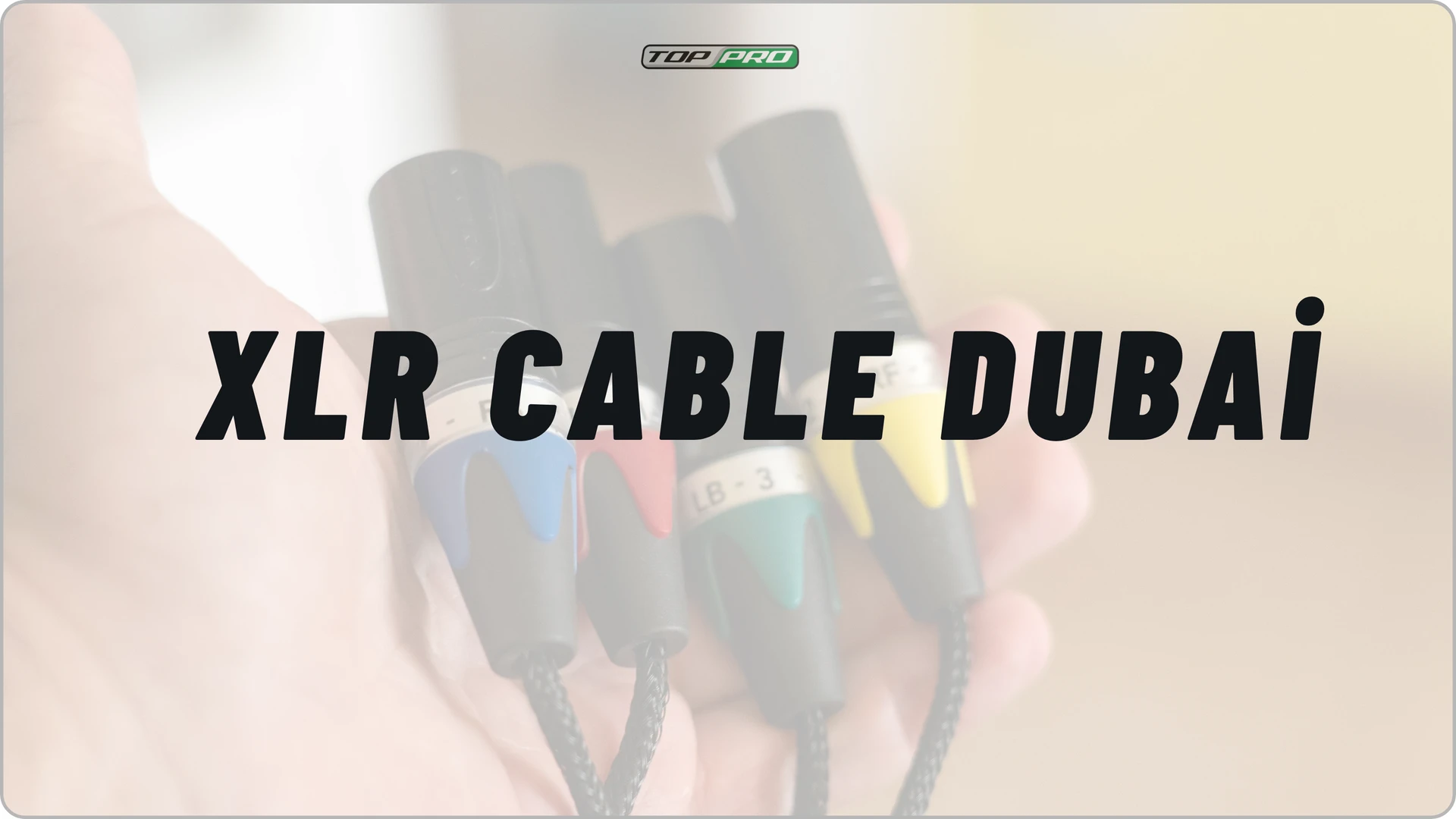Choosing the Best XLR Cable in Dubai

Why XLR Cables Matter More Than Ever?
In audio, one weak link can ruin everything. A poor-quality XLR cable can cause hum, distortion, or even silence—whether you’re recording in a Dubai studio, hosting a podcast, or running live sound at an event. In 2025, choosing the right XLR cable isn’t just about connection—it’s about reliability, clarity, and professional credibility.
This guide breaks down everything you need to know about XLR cables: what they are, how they work, the types available, key buying factors, and how to keep them in top shape for years to come.
What You’ll Learn
By the end of this guide, you’ll know how to:
- Understand the anatomy of an XLR cable and connector types.
- Compare balanced vs. unbalanced XLR cables.
- Match cable types (mic, TRS, TRRS, SpeakON) to the right application.
- Evaluate factors like shielding, cable gauge, and durability.
- Apply best practices for studio, stage, and broadcast setups.
- Maintain and troubleshoot your cables like a pro.
What is an XLR Cable?
An XLR cable is a professional-grade audio cable designed for balanced audio transmission. With three conductors (positive, inverted, ground), XLR cables reduce interference and deliver cleaner signals over long distances. That’s why they’re the gold standard in studios, live sound, broadcasting, and podcasting.
Core Components:
- Conductors: Carry the audio signal.
- Shielding: Protects against electromagnetic and radio-frequency interference.
- Connectors: Rugged three-pin design, easy to lock and release.
Pro tip: Don’t confuse XLR with simple aux cables. Aux is unbalanced and short-distance. XLR is balanced, stable, and built for pro environments.
Types of XLR Connectors
- Three-pin male/female: Standard for microphones and mixers.
- Four-pin and five-pin: Specialized use in lighting, intercom, or stereo signals.
Why it matters: Knowing connector types ensures compatibility with your equipment and prevents mismatched setups.
Key Factors to Consider When Buying
1. Cable Length
Too short? You’re tethered. Too long? Risk of signal degradation. Measure your space and add 1–2 meters of slack without excessive coiling.
2. Cable Gauge
Thicker gauge = lower resistance, useful for long runs. Standard gauge works for short setups.
3. Shielding
Opt for double-shielded or quad-shielded cables in environments with heavy electronics. Better shielding = less hum and interference.
4. Connector Gender
Microphones usually use male outputs, while mixers/amplifiers take female inputs. Always match genders to your gear.
5. Durability
Look for:
- Reinforced connectors.
- Strain relief.
- Rugged outer jacket.
6. Noise Reduction
Balanced cables cancel interference—vital for professional environments. Avoid unbalanced runs beyond a few meters.
7. Compatibility
Check integration with mixers, audio interfaces, and amps. USB/XLR hybrids and wireless adapters are options in modern setups.
8. Cost vs. Value
Cheap cables often fail at the worst times. Mid-range to high-quality cables save money long-term by reducing replacements.
Types of XLR Cables
Microphone Cables (XLR to XLR)
The workhorses. Used to connect mics to mixers or audio interfaces. Balanced design keeps vocals crisp.
Balanced vs. Unbalanced
- Balanced (3 conductors): Ideal for long runs; eliminates interference.
- Unbalanced (2 conductors): Cheaper but noisy over distance; best for short instrument connections.
TRS vs. TRRS
- TRS (Tip-Ring-Sleeve): Stereo or balanced mono connections. Common for headphones and studio gear.
- TRRS (Tip-Ring-Ring-Sleeve): Adds mic channel; found in headsets and mobile devices.
Speaker Cables (XLR to SpeakON)
Designed for connecting amps to pro speakers. SpeakON connectors lock securely, preventing accidental disconnections in live shows.
Applications of XLR Cables
Studio Recording & Live Sound
- Connect mics to preamps or mixers.
- Balanced XLR ensures low noise and consistent quality.
Home Audio Systems
- Audiophiles use XLR to connect high-end amplifiers and powered speakers for superior fidelity.
Stage Performances
- Durable XLR withstands touring conditions. Reliability is non-negotiable for musicians and engineers.
Broadcasting & Podcasting
- Podcasters and broadcasters rely on XLR to deliver noise-free voice transmission. Perfect for speech clarity and professional audio.
Case example: A Dubai podcast studio reduced background hiss by upgrading from single-shield to quad-shield XLR cables.
Maintenance & Care
- Coiling: Use the over-under method. Avoid kinks and twists.
- Storage: Cable reels or ties prevent tangling.
- Connector Protection: Use caps to keep dust out.
- Inspections: Check for fraying or loose connectors every few weeks.
- Cleaning: Wipe connectors with isopropyl alcohol.
- Handling: Always unplug by the connector, not the cable.
Why it matters: Proper care extends lifespan and ensures clean audio during critical performances.
FAQs About XLR Cables
How do XLR cables differ from other audio cables?
XLR uses three conductors for balanced signals, reducing noise. Aux or RCA are unbalanced and more prone to interference.
Can I use long XLR cables without losing signal?
Yes, balanced XLR can run 20–30 meters without noticeable loss if well-shielded.
Are gold-plated connectors worth it?
Gold prevents corrosion and improves long-term reliability. Useful in humid Dubai environments, but not mandatory for all setups.
Can XLR cables be used for both mics and instruments?
Yes, as long as connectors match. Some instruments need adapters for XLR integration.
Can I mix XLR with TRS cables?
Yes, with the right adapters. But ensure your system stays balanced to avoid noise issues.
Final Thoughts
In Dubai’s audio scene—whether it’s a studio session, live stage, or corporate event—the right XLR cable can mean the difference between flawless sound and a failed performance. By choosing high-quality, well-shielded cables, matching them to your setup, and maintaining them properly, you ensure every note, word, and sound reaches your audience exactly as intended.







